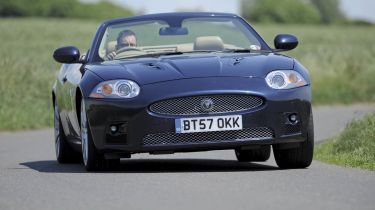Jaguar XKR Convertible
Big cat offers luxury and performance in a premium package.
It's a debate that goes back to the original XK120, continued with the E-Type and is still raging today. Do Jaguar’s flagship sports cars have more appeal in coupé or convertible form?
In truth, it comes down to personal taste, and Jaguar placed equal weight on both variants when it developed the new XK.
As a result, the drop-top Jaguar shouldn’t suffer any compromises over the coupé. We don’t think it is quite as elegant as the hard-top, which has a longer roofline and sleeker profile, but with its big rear haunches, the Convertible still has plenty of attitude.
Nevertheless, it doesn’t look at its best until the fabric hood has been lowered. And this is an easy process – the fully automated top lowers quicker than the BMW’s and the 207’s. Just don’t expect anything too clever.
The traditional operation folds the fabric beneath a solid panel to leave a smart rear deck. As with the BMW, the XKR has no ungainly roll hoops; instead, it relies on bars that automatically shoot up in the event of a potential rollover accident.
Stowing the top doesn’t reduce the boot capacity as much as in the coupé-cabrios tested here. The floor is high, though, so it might struggle to take big loads. And while the tiny rear seats have Isofix mountings, space is so tight, few child seats will fit.
Up front, the beautifully constructed dashboard helps to create an attractive and cosy cabin. The touchscreen system is excellent, and few models in any price bracket can match the XK’s elegance.
It’s not only the interior that feels special, as getting behind the wheel of this car is always a special event. The XKR is effortlessly easy to drive and feels remarkably light and agile on the road. The CATS adaptive dampers absorb imperfections well, while body control is fantastic, too. Communicative steering completes the dynamic package. The best thing about driving with the roof down in the supercharged flagship is being able to savour the gorgeous V8 exhaust note. The pay-off is a fraction more vibration and body flex than in the coupé, although it rarely detracts from the performance.
Silky-smooth power delivery throughout the rev range, combined with slick shifts from the steering wheel-mounted paddles, means acceleration is truly effortless.
The XKR is generously equipped – but so it should be, given its hefty £76,995 price. Running costs and fuel consumption are also eye-watering in this company, although they’re not unacceptable in the supercar class. And even though the Jaguar isn’t the newest model in our quartet, it turned more heads than any other model.
It’s an extravagant luxury, but the XKR Convertible almost achieves the impossible by justifying its lofty price.
Details
Price: £76,995
Model tested: Jaguar XKR Convertible
WHY: Potent diesel engine and stunning metal roof make the 3-Series worthy of inclusion.
Economy
If you want exclusivity, five-star luxury and supercar performance, you’d better be ready to pay for it. An average of 18.8mpg will leave XKR cabrio drivers with annual fuel costs of £3,378, while emissions in the top bracket translate into a £10,779 company car tax bill. Servicing isn’t cheap, either – 10,000-mile intervals call for regular visits to the garage, and the first three checks will cost a total of £1,099. At least an impressive 62.6 per cent retained value limits depreciation.







